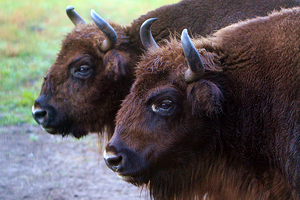Ru
|
Eng
Union State bison breeding program to get RUB600 million
02.10.2014

Almost RUB600 million will be allocated for the Belarus-Russia Union State program with the focus on the formation of an optimal areal of the European bison as a guarantee for its long-term presence (Roadmap for Bison), Counselor of the Department for Economic and Sectoral Programs of the Union State Permanent Committee Gennady Vanyukov told media on 2 October, BelTA has learned.
“The program is designed for 2015-2019. It is expected that the program will be financed from the Union State budget,” Gennady Vanyukov said.
The Union State draft concept Roadmap for Bison was worked out by the scientific practical center for bioresources of the National Academy of Sciences of Belarus (NASB) and A.N. Severtsov Institute of Ecology and Evolution under the Russian Academy of Sciences in November 2013 with the participation of the state environmental institution, the National Park Belovezhskaya Pushcha.
The main goal of the project is to preserve the European bison as a biological species in a long-term perspective. One of its possible solutions includes the restoration of fragments of the previous areal of the bison on the territory of the Union State for the introduction of its full-scale population.
According to Academician, Secretary of the NASB Department of Biological Sciences, Director General of the NASB scientific practical center for bioresources Mikhail Nikiforov, once the native habit of the lowland bison covered the whole territory of Belarus, the middle and southern part of the European Russia. “We need to find lands appropriate for the recreation of the natural habit of the lowland bison. Which country has the appropriate territory in Europe? Russia, of course. Belarus has experience, a reserve for the bison population, we have more than 300 species ready to be resettled to new territories,” Mikhail Nikiforov said.
The scientist stressed that before inhabiting new lands it is necessary to select the most valuable species from the genetic perspective. “They should be distributed among breeding nurseries. There are two nurseries in Russia and one more will be built in Belovezhskaya Pushcha. The young ones will be introduced to the new selected areas,” Mikhail Nikiforov.
Another step in the implementation of the program is the use of advanced monitoring methods. “It is impossible to watch every bison with a binocular. We plan to use the latest methods of distant monitoring: chips and unmanned equipment,” the scientist said.
According to Mikhail Nikiforov, the concept of the program is innovative in many aspects. “Every step means innovations. It is of great importance to implement the program,” he stressed.
“The program is designed for 2015-2019. It is expected that the program will be financed from the Union State budget,” Gennady Vanyukov said.
The Union State draft concept Roadmap for Bison was worked out by the scientific practical center for bioresources of the National Academy of Sciences of Belarus (NASB) and A.N. Severtsov Institute of Ecology and Evolution under the Russian Academy of Sciences in November 2013 with the participation of the state environmental institution, the National Park Belovezhskaya Pushcha.
The main goal of the project is to preserve the European bison as a biological species in a long-term perspective. One of its possible solutions includes the restoration of fragments of the previous areal of the bison on the territory of the Union State for the introduction of its full-scale population.
According to Academician, Secretary of the NASB Department of Biological Sciences, Director General of the NASB scientific practical center for bioresources Mikhail Nikiforov, once the native habit of the lowland bison covered the whole territory of Belarus, the middle and southern part of the European Russia. “We need to find lands appropriate for the recreation of the natural habit of the lowland bison. Which country has the appropriate territory in Europe? Russia, of course. Belarus has experience, a reserve for the bison population, we have more than 300 species ready to be resettled to new territories,” Mikhail Nikiforov said.
The scientist stressed that before inhabiting new lands it is necessary to select the most valuable species from the genetic perspective. “They should be distributed among breeding nurseries. There are two nurseries in Russia and one more will be built in Belovezhskaya Pushcha. The young ones will be introduced to the new selected areas,” Mikhail Nikiforov.
Another step in the implementation of the program is the use of advanced monitoring methods. “It is impossible to watch every bison with a binocular. We plan to use the latest methods of distant monitoring: chips and unmanned equipment,” the scientist said.
According to Mikhail Nikiforov, the concept of the program is innovative in many aspects. “Every step means innovations. It is of great importance to implement the program,” he stressed.
SCIENCE. TECHNOLOGY. INNOVATIONS
13.08.2024
28.06.2024
28.06.2024
25.06.2024
05.06.2024
15.05.2024
15.05.2024
26.04.2024
26.04.2024
26.04.2024













